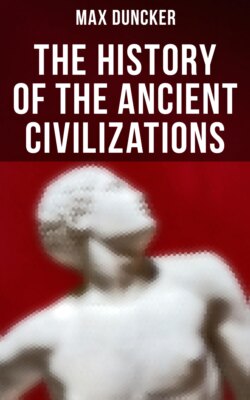Читать книгу The History of the Ancient Civilizations - Duncker Max - Страница 34
На сайте Литреса книга снята с продажи.
FOOTNOTES:
Оглавление[497] In Strabo, p. 756.
[498] Philo. Frag. 1. ed. Müller.
[499] Philon. frag. 1, 6, 7, ed. Müller.
[500] Loc. cit. 2, 1–4, ed. Müller; cf. Bunsen, "Ægypten," 5, 1, 257 ff.
[501] Such is obviously the meaning of this passage.—Baudissin, "Abh. z. semit. Relig." s. 14.
[502] Fragm. 2, 4, 5, ed. Müller.
[503] Pausan. 5, 7, 10.
[504] "Hist. Nat." 36, 65.
[505] Athar-ath, i.e. Astarte-Athe; Brandis, "Münzwesen," s. 431. Diod. 2, 4, 30. 2 Maccab. xi. 26.
[506] Herod. 1, 105. Pausan. 1, 14, 7.
[507] Lucian, "De Dea Syria," c. 16. The cutting off of the hair which Lucian mentions is also a vicarious custom.
[508] Justin. 18, 3.
[509] Movers, "Phœniz." Encycl. v. Ersch. s. 388, ff.
[510] 2 Kings xxiii. 7. Ezek. xxiii. 40, ff.
[511] Movers, "Phœniz." 1, 197, 579; Munter, "Tempel der Göttin von Paphos," and the Syrian coins in De Luynes, "Numismatique," pl. 1. Lucian, "De Dea Syr." 13, 28. On the pillars of Marathus and Paphos, Gerhard, "Kunst der Phœniker," s. 23.
[512] Xenoph. "Anab." 1, 4; Diod. 2, 4; Lucian, loc. cit. 14.
[513] Lucian, loc. cit. 33, 39.
[514] Stark, "Forschungen," s. 248, ff.
[515] Avien. "Ora maritima," v. 305.
[516] De Bell. Parth. 28.
[517] Judges xiv. 23; 1 Samuel, v. ff.
[518] Gesenius, "Monum. Tab." 25. Silius Ital. Pun. 3, 104.
[519] Osborne, "Egypt," p. 144.
[520] Baudissin ("Jahve et Moloch," p. 47) regards the amalgamation of Moloch and Adar as of later origin; to me the connection between Saturn and the sun (Diod. 2, 30) appears of later origin.
[521] e.g. Diod. 20, 65.
[522] Justin. 18, 6. 19, 1; Plin. "H. N." 36, 4.
[523] Curtius, 4, 15, ed. Mützell; "Porphyr. de Abstinentiâ," 2, 56.
[524] Euseb. "Præcept. Evang." 4, 26.
[525] 2 Kings iii. 27; see below.
[526] Diod. 13, 86.
[527] Diod. 20, 14.
[528] Plut. "De Superstitione," p. 171; Sil. Ital. 4, 767.
[529] Numen virginale; virgo cælestis.
[530] De Luynes, "Numism." pl. v.; Hockh. "Kreta," 1, 98.
[531] Lucian, "De Dea Syria," 4, 32; Augustin, "De Civitate Dei," 2, 26.
[532] Movers, "Religion der Phœn." s. 605, 611, 621 ff.
[533] Procop. "De bello Persico," 2, 28.
[534] Lucian, "De Dea Syr." 15, 27, 43, 50, 51.
[535] Movers, "Religion der Phœn.," s. 681.
[536] "Our Lord Melkarth, Baal of Tyre," as he is called in an inscription found at Malta.
[537] Herod. 2, 44; Plin. H. N. 37, 75; Theophr. "De Lap." 25.
[538] Thus Virgil says of the minstrel of Dido: "Canit errantem lunam, solisque labores," Æn. 1, 742.
[539] Joseph. Ant. 8, 53; Movers, "Religion der Phœnizier," s. 150.
[540] Athen. p. 392; Movers, loc. cit. s. 536.
[541] 1 Kings xviii. 28.
[542] Plaut. "Merc." 4, 6.
[543] Cic. "De Nat. Deorum," 3, 23; 1 Macc. v. 43; 2, xii. 26.
[544] Pausan. 3, 23, 1.
[545] Movers, "Phœniz." 2, 230.
[546] Sil. Ital. 4, 81, 819; Justin. 18, 6.
[547] Virg. "Æn." 1, 742.
[548] Hesychius: "Εὐρωπὸν σκοτεινόν, πλατύ. Εὐρώπη ἡ χώρα τῆς δύσεως ἤ σκοτεινή." That Europe is Astarte follows from Hesychius: "Ἑλλωπία, ἑορτὴ Εὐρώπης ἐν Κρήτῃ." The "Etymolog. Mag." pp. 232, 333, says: "Europa was anciently called Hellotia, 'ὅτι οἱ φοίνικες τὴν παρθένον Ἑλλωτίαν καλοῦσιν.'" Eloth signifies "goddess."
[549] Jeremiah vii. 18; xliv. 17–23.
[550] Pindar, "Pyth." 3, 90; Cic. "De Nat. Deor." 3, 23.
[551] Appian, "De Reb. Hisp." c. 2; Movers, "Kolonieen der Phœnizier," s. 63 ff. We shall see below what a conglomeration of fables the Greeks have gathered round the wandering Astarte, who rides on a bull and is represented with the crescent of the moon, and a cow's horns. With them she is not only Europe whom the Bull-Zeus carries from Phœnicia, who is sought by Cadmus the son of Phœnix. In her crescent and cow's horns they also recognise their Argive Moon-goddess, Io, and represent her as wandering to Phœnicia and Egypt, where Isis, who here again wears the cow's horns or head, or is entirely represented as a cow, becomes their Io. The wanderings of Dido-Astarte then became confused with the stories of Helena, with the wanderings and fortunes of the foundress of Carthage, and the travels of Æneas, the favourite of Aphrodite, were directed to the most famous seats of the worship of Ashera.
[552] Nöldeke, "Inschrift des Mesa."
[553] Serv. ad Æn. 2, 632; Gerhard, "Kunst der Phœniker," s. 36, 38.
[554] According to Lenormant, um-pali, "mother of the sword."
[555] Joh. Lyd. "De Mensibus," 4, 46.
[556] Lev. xix, 27–29; Deut. xiv. 1; xxii. 5; xvi. 21; xxiii. 1.
[557] Ezek. viii. 14.
[558] Lucian, "De Dea Syria," c. 8; Strabo, p. 755.
[559] "De Laudib. Constant." c. 13.
[560] Bunsen, "Ægypten," 5, 1, 379.
[561] Herod. 3, 37; Gerhard, "Kunst der Phœnicker Taf." 4, 5; Movers, "Phœnizier," 2, 87–99; "Phœniz." in Ersch. s. 391 ff.
[562] Jerem. x. 5; Baruch, vi. 3, xxv. 26; Diod. 20, 65.
[563] Lucian, "De Dea Syria," c. 49.
[564] Polyb. 31, 20; Diod. 20, 14; Just. 18, 7; Curt, 4, 13.
[565] 1 Kings xviii. 17–24.
[566] Movers, "Phœniz." in Ersch. s. 419.
[567] Movers, "Opferwesen der Karthager," s. 8; Blau, "Opfertarif von Karthago;" Zeitschrift d. d. M. G. 16, 438.
